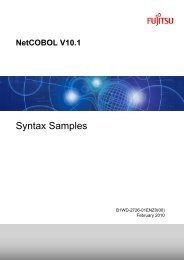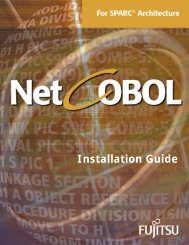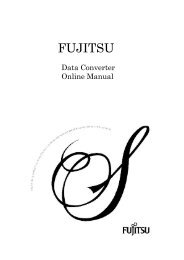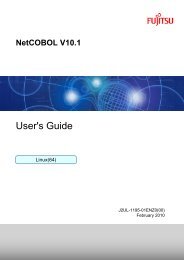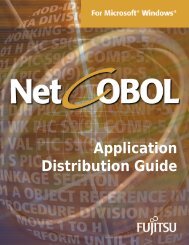NetCOBOL for SPARC Architecture SAF Subroutines User's Guide
NetCOBOL for SPARC Architecture SAF Subroutines User's Guide
NetCOBOL for SPARC Architecture SAF Subroutines User's Guide
You also want an ePaper? Increase the reach of your titles
YUMPU automatically turns print PDFs into web optimized ePapers that Google loves.
Chapter 1. <strong>NetCOBOL</strong> <strong>SAF</strong> <strong>Subroutines</strong><br />
Overview of <strong>SAF</strong><br />
<strong>SAF</strong> (Server Application Functions) is an application generated by using the NSAPI<br />
(Netscape Server Application Programming Interface).<br />
The NSAPI is an interface provided <strong>for</strong> extending the NES (Netscape Enterprise<br />
Server). <strong>SAF</strong> is included in the NES and runs as a thread so that it operates faster<br />
than CGI. It can save resource consumption including memory. Since <strong>SAF</strong> operates<br />
as a thread, however, the thread must be thread safe. If resources have not been<br />
released, you may not be able to use the resources until NES terminates, so caution<br />
must be taken.<br />
Browser<br />
Browser<br />
Request<br />
Response<br />
Request<br />
Response<br />
<strong>NetCOBOL</strong> <strong>SAF</strong> <strong>Subroutines</strong><br />
Process<br />
Thread<br />
<strong>SAF</strong><br />
Thread<br />
<strong>SAF</strong><br />
NSAPI<br />
The Web subroutines using NSAPI are called <strong>NetCOBOL</strong> <strong>SAF</strong> subroutines (hereafter,<br />
called <strong>SAF</strong> subroutines). The environment in which Web applications are generated<br />
by using <strong>SAF</strong> subroutines is called the <strong>NetCOBOL</strong> <strong>SAF</strong> director (hereafter, called <strong>SAF</strong><br />
director). The <strong>SAF</strong> director loads and executes Web applications generated by using<br />
the <strong>SAF</strong> subroutines. The Web applications are loaded when NES is started or at<br />
initial request, and the application resides in memory after that. The applications are<br />
not unloaded until NES is terminated.



